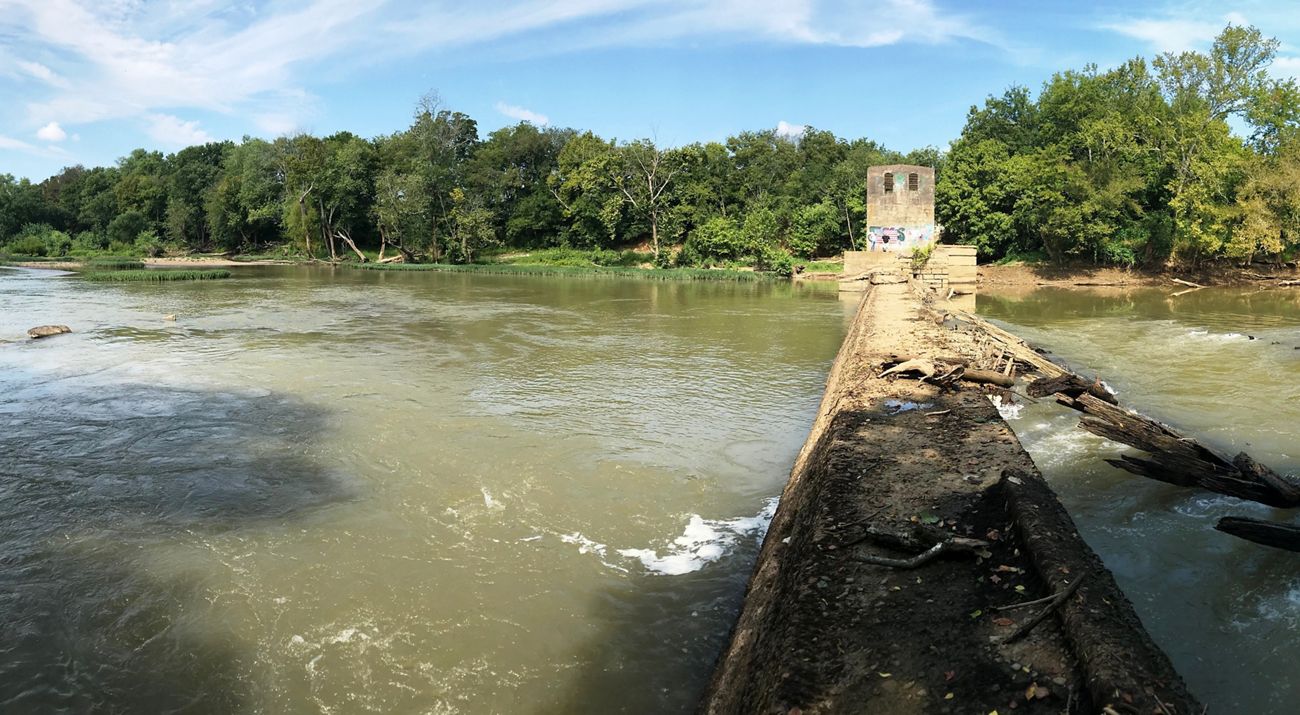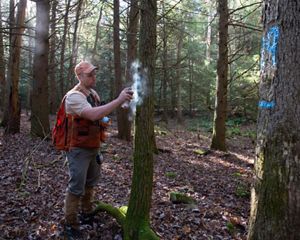Rethinking Tennessee’s Dams
Many of Tennessee's dams don't fulfill their original purpose, and even cause harm.

Rivers harbor some of the most diverse aquatic ecosystems in the nation, supporting more than 300 species of fish and hundreds of freshwater mussels. Among them is the Pygmy Madtom (Noturus stanauli), one of the rarest freshwater fish in the United States, found only in the Clinch and Duck Rivers in Tennessee. The Duck River alone supports more mussel species than any other river in North America—these mussels play a vital role in maintaining water quality.
Beyond biodiversity, rivers are essential to Tennessee’s economy, communities, and public health. They generate hydropower, supply drinking water to people, irrigate crops, and fuel a thriving outdoor recreation and tourism industry. Rivers are central to what makes Tennessee unique—ecologically, economically, and culturally—and are a priority in our water program.


Threats from Obsolete Dams
Some of Tennessee’s rivers are in peril, threatened by obsolete and often dangerous dams and other barriers that prevent them from delivering vital benefits to people and nature.
Many dams no longer serve their original purpose, like powering mills or providing road access, and can be a serious problem for three primary reasons:
They jeopardize safety, including tragic drownings that happen each year when people get too close or underestimate their power.
They disrupt the natural flow of rivers and fragment important habitat for aquatic species, leading to declines in their populations.
They limit recreational access to portions of a river where people could otherwise enjoy the water and the surrounding nature.
Prioritizing Dam Removal Projects
TNC is working strategically with partners to inventory, prioritize, and, when appropriate, systematically remove dams that no longer serve a useful purpose and pose a threat to human and river health. So far, TNC has inventoried almost 2,000 dams around the state. Of those, we prioritized the top 10 most likely to make the biggest impact with regard to safety, habitat connectivity, and recreation.
Removing a dam is a team effort. TNC works with many partners to assess the site, design the project, collect sensitive species, gather all the funding needed to complete the project, and measure results. Dam removals take time, but with continued support, we aim to build a project pipeline that, through strong partnerships and financial resources, will remove three to five outdated dams in the next five years and deliver the greatest possible conservation outcomes.
Harms Mill Dam Removal
Harm’s Mill Dam removal is the largest of its kind in Tennessee. This ambitious project, done in partnership with the Tennessee Wildlife Resources Agency (TWRA), took over three years to plan, assess, fund, and implement, culminating in the dam’s removal in October 2025. For decades, the dam separated 804 linear miles of downstream habitat from 780 miles upstream in the Elk River, but its removal has now reconnected 1,114 miles of free-flowing river, opening vital pathways for fish and aquatic wildlife migration.
The Elk River is home to 19 federally endangered species, including the rare Boulder darter, making this restoration especially significant for biodiversity. In addition to its ecological importance, the site posed a major public safety risk due to its deteriorating structure—an abandoned hydroelectric mill first built by the Harms Brothers in 1870 as a textile mill, later expanded with a hydropowered generator in 1905. Fayetteville Light and Power purchased the property in 1920 and completed a new concrete dam and powerhouse in 1922. While the mill and hydroelectric facility once played an important role in the development of Fayetteville and the surrounding area, they eventually became obsolete and fell into disrepair, leaving behind a hazardous structure that attracted young crowds.
The Elk is a major destination for paddlers, and the dam removal offers a great opportunity for more aquatic outdoor activities. This project was made possible through the support of the National Fish and Wildlife Foundation, Tennessee Valley Authority, and Maddox Family Foundation, whose funding ensured the successful restoration of one of Tennessee’s most ecologically important rivers.
Dam Removal Process
2021
Acquisition by TWRA


The Tennessee Wildlife Resources Agency (TWRA) officially acquired ownership of the dam, marking the first major step toward its eventual removal.
2024
Permitting Milestone


After years of environmental review and coordination with state and federal agencies, all necessary permits for dam removal were finalized.
2025
Dam Removal


TWRA initiated the contracting process for construction. This phase focused on logistics, safety planning, and mobilizing resources to ensure the project could proceed efficiently once approvals were in place.

The project received final authorization to execute the construction contract. Ahead of removal, biologists and field teams collected fish and mussels from the river—species that could be threatened by the disturbance.

Construction crews began dismantling the dam, and within just one week, the majority of the structure was successfully removed. This marked a transformative moment for the river ecosystem.
Lower Citico Creek Dam Removal
Nestled in the Cherokee National Forest, Citico Creek is a hotspot for biodiversity, including two endangered fish species—the Citico darter and the smoky madtom—and one threatened species, the yellowfin madtom. The Lower Citico Creek offers critical habitat for these species, which, for decades, were blocked from moving freely along the stream system by a dam. Removal of the dam now allows populations to migrate upstream and downstream to find new habitat, improving overall ecosystem health.
The dam itself was built in the 1970s to protect a trout fishery on Citico Creek. At the time, the prevailing theory was that eliminating native “rough” fish would benefit trout populations, so this dam and another upstream barrier (removed in 2015) were installed to prevent native fish from entering the fishery. More recent research has shown the opposite: complete ecosystems that include native fish species are actually beneficial to fisheries, underscoring the importance of restoring natural connectivity.
By removing the Lower Citico Creek dam in August 2025, after years of study and preparation by US Forest Service biologists, Conservation Fisheries, University of Tennessee, the State of Tennessee, and the US Fish and Wildlife Service, the project reconnected 76 upstream perennial miles of river. The dam had also been showing signs of failure, with crumbling concrete and exposed rebar posing risks to people and the river's health.
The Nature Conservancy in Tennessee and Trout Unlimited worked together to design and implement this project, ensuring that Citico Creek can once again flow freely—supporting endangered species, strengthening fisheries, and safeguarding one of Tennessee’s most ecologically important waterways.
Roaring River Dam Removal
Originally constructed in 1973 as a fish barrier to prohibit migration of non‑game species into the Roaring River from Cordell Hull Reservoir, the dam ultimately hindered migration of numerous native fish species, including white bass, redhorse, sauger, and smallmouth bass. Its removal reconnected 78 upstream perennial miles of river, according to the National Aquatic Connectivity Collaborative Aquatic Barrier Inventory and Prioritization Tool, restoring aquatic organism passage and revitalizing the river ecosystem.
The removal of the Roaring River dam in 2017 was done in partnership with the Tennessee Wildlife Resources Agency (TWRA), the Army Corps of Engineers, the U.S. Fish & Wildlife Service, the Tennessee Department of Environment & Conservation, and the Southeast Aquatic Resources Partnership.
The ecological benefits have been clear: the impounded area behind the dam was effectively restored to flowing water habitat, and post‑removal monitoring by TWRA and Tennessee Tech documented fish assemblages, as well as upstream migration by redhorse, great indicators of a healthy habitat. This project not only removed a barrier but also demonstrated how dam removal can restore ecological function, improve fisheries, and reconnect communities with healthier rivers.
Get Updates from the Field
Subscribe to our newsletter and get monthly stories about our conservation work across Tennessee.









